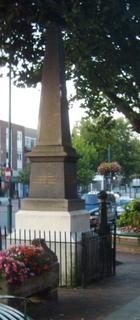
The issue has made me reflect on two public memorials that I know something about, which are both in Rayleigh. The first is a granite obelisk in the High Street, to commemorate four protestants who were burned to death in the 1550s, during the reign of Queen Mary. A curate from Hockley called Tyms and the rector of Thundersley called Drake were executed at Smithfield in London in April 1556. Thomas Causton was burned in Rayleigh High Street early in 1555 . According to John William Burrow's "Southend-On-Sea and District : Historical Notes": "So great was popular feeling that he was led to the place of death bound in a cart for fear of rescue". John Ardeley from Great Wigborough was burned there the same year.
The memorial itself was unveiled on September 23rd 1908 by the local MP Rowland Whitehead (incidentally a Liberal MP, probably the only one so far to represent this area) in front of a crowd of 2000 people. It is a dignified and rather eternal-looking structure and is a familiar part of the street scene.

The second memorial is much more recent , having been commissioned by the District Council in the last few years. It is a memorial to the victims of persecution, in a small open space in front of one of our main public buildings, the Mill Hall. When I first saw the design I though it was ugly, but when I understood the explanation I changed my mind, and now I really like it:
The interpretation of the design, supplied by the Architect, is as follows:
• The stone plinth represents a solid foundation upon which Society rests.
• The three finish concrete slab reflects the ability of man to repair what has
been damaged, i.e. rough to smooth, but reminds us that we can also
destroy the perfect finish.
• The three steel posts in alternative finishes represent the technological
progress of man, and the diverse states of development throughout the
world.
• The rough sawn and smooth posts running through the structure reflects
the ability of man to twin raw products with a finished product, and the
unity of our manmade and shaped society by organic and living materials.
• The Star of David, which would only be viewed in full when standing in
front of the memorial, is a direct reference to the Nazi Holocaust, but
reminds us that looking at it from another viewpoint leads to fragmentation
and separation of this iconic symbol, reflecting persecution.
• The horizontal element of the concrete slab and its relationship with the
constancy of the plinth is to remind and encourage us from the solid basis
of society, man can shape and reshape society, but not always for the
good.
• The vertical steel plates, whilst reflecting a straight line upwards, (the
conventional approach to seeking a higher power regardless of faith or
religion), also create open spaces between them, perceived as people
choose.
• Planting to each side, centrally, and the centre plate are intended to
remind us that the living world has the ability to grow i n even the most
barren places, usually the first visible step to reconciliation and
reconstruction following conflict and persecution.
• The orientation of the structure should be on an East-West axis, the
conventional orientation of churches and western faiths with the dedication
stone in the east reflecting the alter position, also recognising that the sun
rises in the East. At the same time, the structure can be viewed from all
points, to remind us that we all have different perceptions.
So what does my small-town English experience tell me about the "Crescent of Embrace"? Well, that memorials are very long-term projects, hopefully with life-spans of centuries. That they don't need to be conventionally beautiful to be effective. Also, that they need public support. For myself, I'd change the design of the red crescent into something with a different title- and a somewhat different shape. Such a project shouldn't be born in the middle of a political argument.
No comments:
Post a Comment